ASUSTeK Computer EPC9GE780 Eee PC User Manual Manual 2
ASUSTeK Computer Inc Eee PC Manual 2
Contents
Manual 2
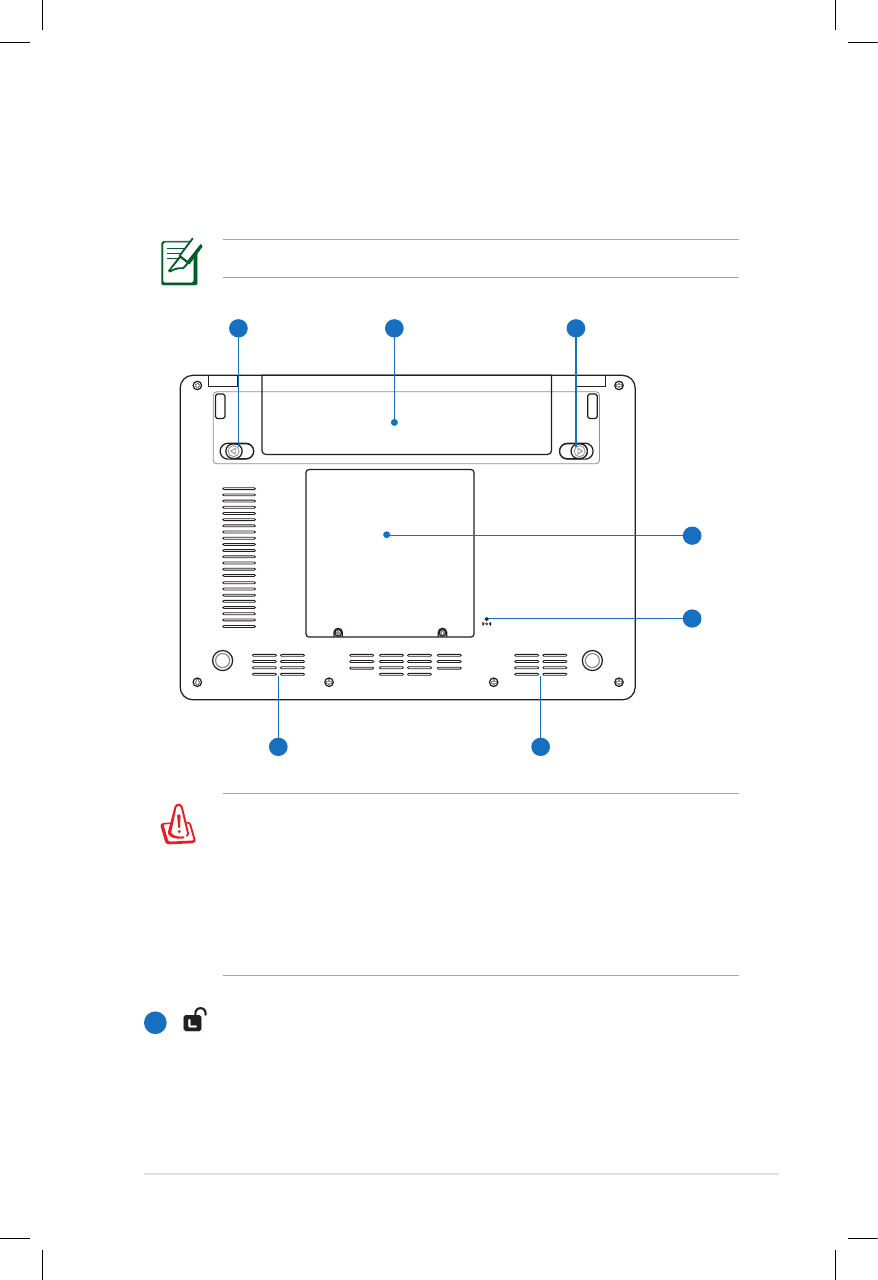
ASUS Eee PC
2-5
Bottom Side
Refer to the illustration below to identify the components on this
side of the Eee PC.
The bottom side may vary in appearance depending on model.
The bottom of the Eee PC can get very hot. Be careful when
handling the Eee PC while it is in operation or recently been in
operation. High temperatures are normal during charging or
operation. DO NOT use on soft surfaces such as beds or sofas
,which may block the vents. DO NOT PUT THE Eee PC ON YOUR
LAP OR OTHER PARTS OF THE BODY TO AVOID INJURY FROM THE
HEAT.
21 3
5
4
6 6
Battery Lock - Spring
The spring battery lock keeps the battery pack secure.
When the battery pack is inserted, it will automatically lock.
When removing the battery pack, this spring lock must be
retained in the unlocked position.
1
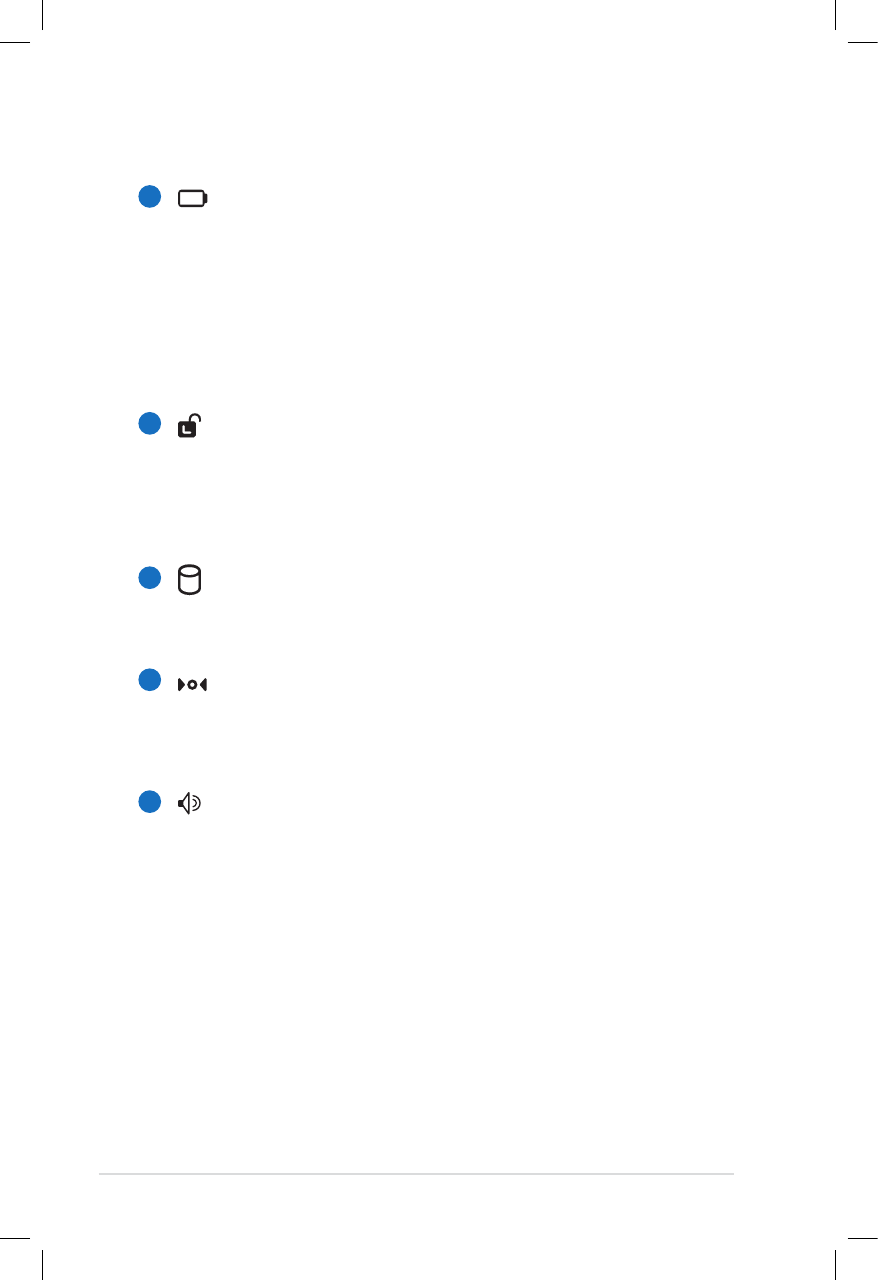
2-6
Chapter 2: Knowing the Parts
Battery Pack
The battery pack is automatically charged when connected
to an AC power source and maintains power to the Eee PC
when AC power is not connected. This allows use when
moving temporarily between locations. Battery time
varies by usage and by the specifications for this Eee PC.
The battery pack cannot be disassembled and must be
purchased as a single unit.
Battery Lock - Manual
The manual battery lock is used to keep the battery pack
secured. Move the manual lock to the unlocked position to
insert or remove the battery pack. Move the manual lock to
the locked position after inserting the battery pack.
Solid-State Disk & Memory Compartment
The solid-state disk drive and memory are secured in a
dedicated compartment.
Reset Button (Emergency)
In case your operating system cannot properly turn OFF or
restart, the reset button can be depressed with a pin or a
straightened paper clip to restart the Eee PC.
Audio Speaker System
The built-in stereo speaker system allows you to hear audio
without additional attachments. The multimedia sound
system features an integrated digital audio controller
that produces rich, vibrant sound (results improved with
external stereo headphones or speakers). Audio features
are software controlled.
2
3
4
5
6
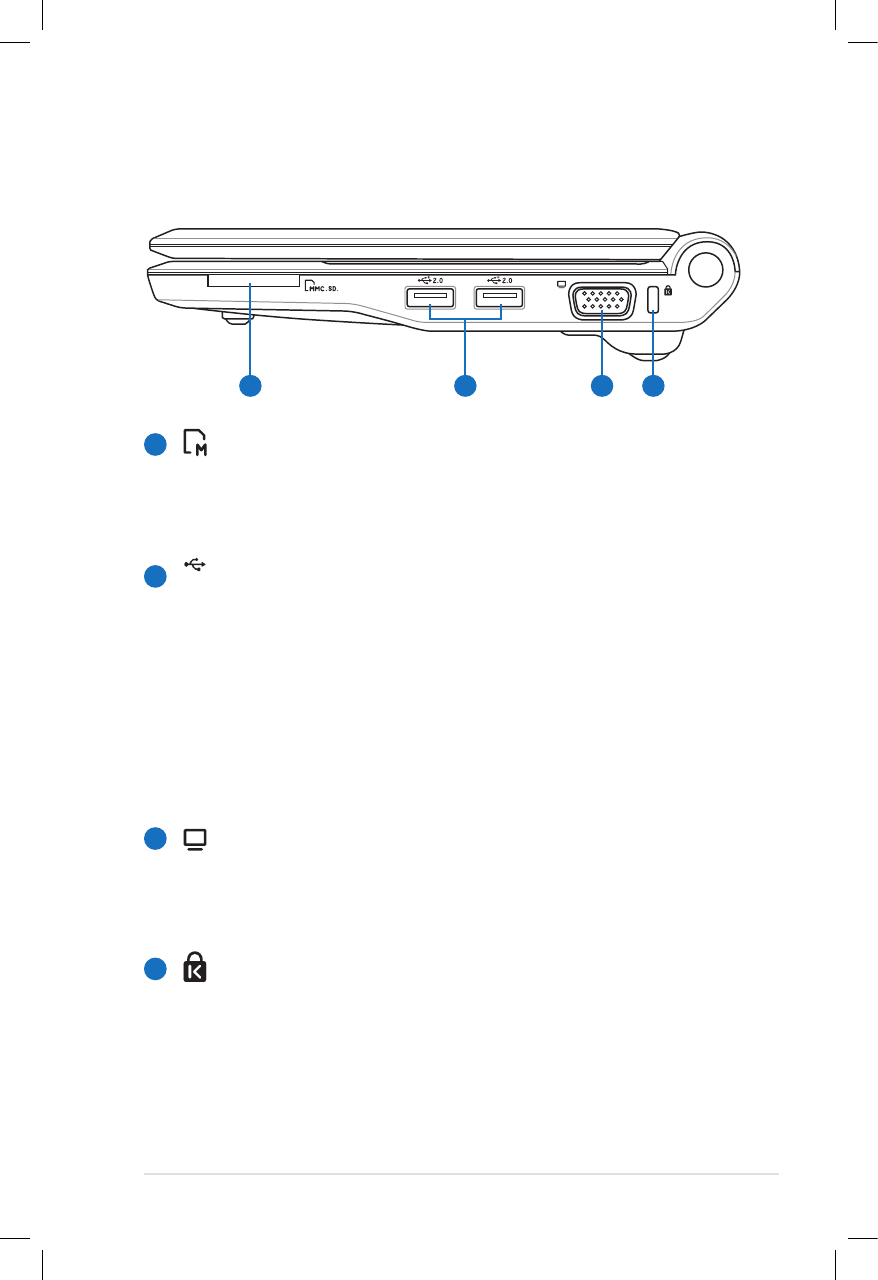
ASUS Eee PC
2-7
Right Side
Refer to the illustration below to identify the components on this
side of the Eee PC.
1 2 3 4
Memory Card Slot
The built-in memory card reader can read MMC/SD cards
from devices such as digital cameras, MP3 players, mobile
phones, and PDAs.
2.0
USB Port (2.0/1.1)
The USB (Universal Serial Bus) port is compatible with USB
2.0 or USB 1.1 devices such as keyboards, pointing devices,
cameras, and storage devices, connected in a series up to
12Mbits/sec (USB 1.1) and 480Mbits/sec (USB 2.0). USB
allows many devices to run simultaneously on a single
computer, with some peripherals acting as additional
plug-in sites or hubs. Also, the USB supports hot-swapping
function.
Display (Monitor) Output
The 15-pin D-sub monitor port supports a standard VGA-
compatible device such as a monitor or projector to allow
viewing on a larger external display.
Kensington® Lock Port
The Kensington® lock port allows the Eee PC to be secured
using Kensington®
compatible security products. These
security products usually include a metal cable and lock
that prevent the Eee PC to be removed from a fixed object.
1
2
3
4
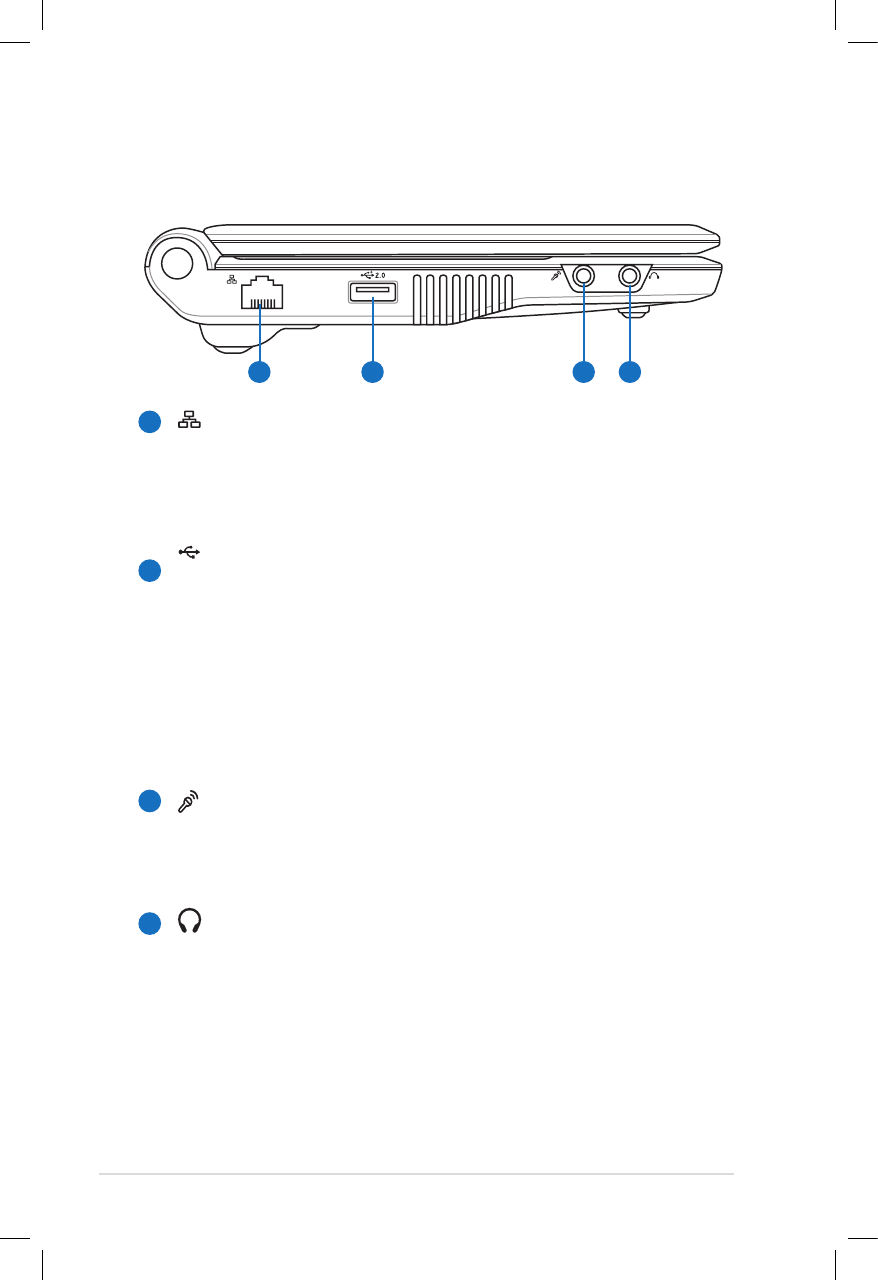
2-8
Chapter 2: Knowing the Parts
12 3 4
Left Side
Refer to the illustration below to identify the components on this
side of the Eee PC.
LAN Port
The eight-pin RJ-45 LAN port (10/100M bit) supports a
standard Ethernet cable for connection to a local network.
The built-in connector allows convenient use without
additional adapters.
2.0
USB Port (2.0/1.1)
The USB (Universal Serial Bus) port is compatible with USB
2.0 or USB 1.1 devices such as keyboards, pointing devices,
cameras, and storage devices, connected in a series up to
12Mbits/sec (USB 1.1) and 480Mbits/sec (USB 2.0). USB
allows many devices to run simultaneously on a single
computer, with some peripherals acting as additional plug-
in sites or hubs. Also, it supports hot-swapping function.
Microphone Jack
The microphone jack is designed to connect the
microphone used for Skype, voice narrations, or simple
audio recordings.
Headphone Output Jack
The 1/8” stereo headphone jack (3.55mm) connects the Eee
PC’s audio out signal to amplified speakers or headphones.
Using this jack automatically disables the built-in speakers.
1
2
3
4
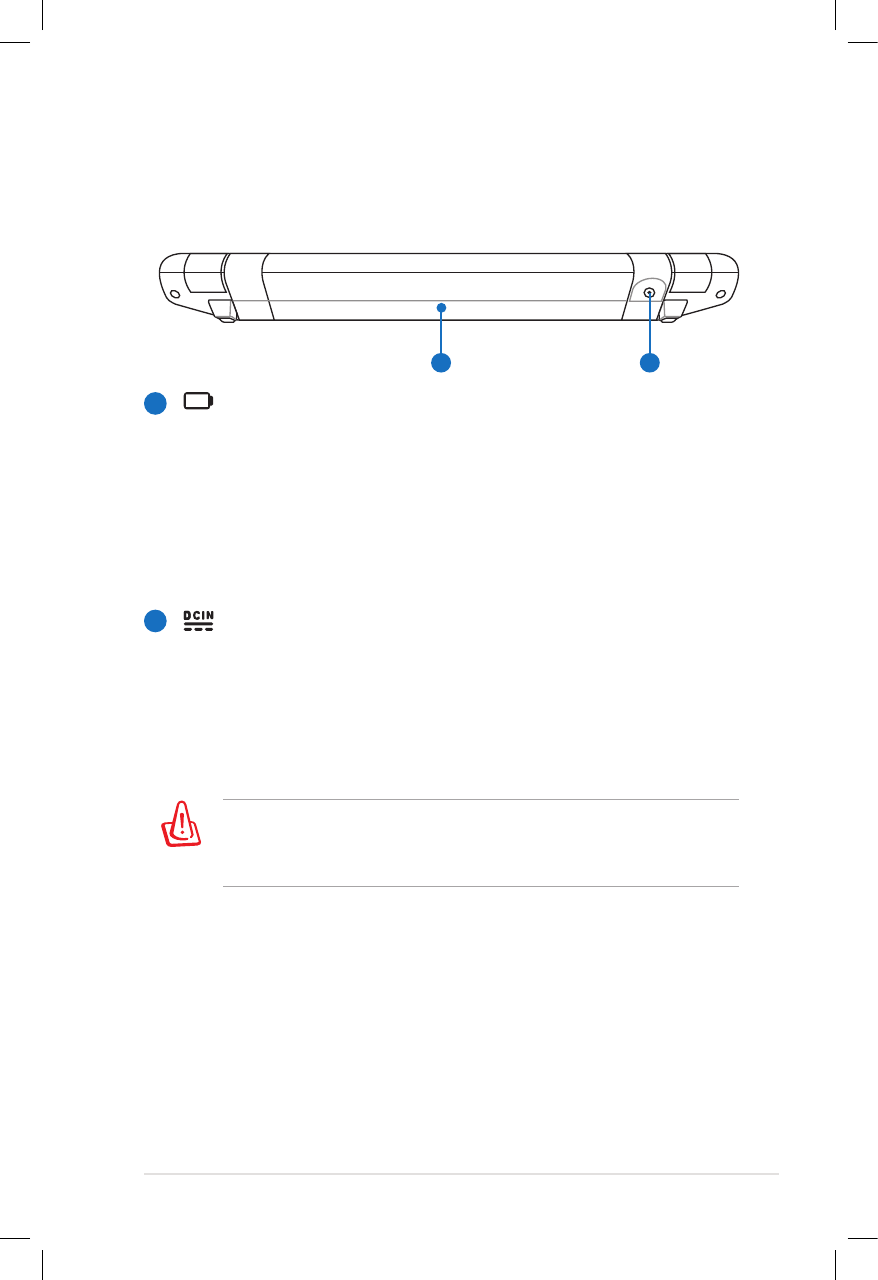
ASUS Eee PC
2-9
Rear Side
Refer to the illustration below to identify the components on this
side of the Eee PC.
1 2
Battery Pack
The battery pack is automatically charged when connected
to an AC power source and maintains power to the Eee PC
when AC power is not connected. This allows use when
moving temporarily between locations. Battery time
varies by usage and by the specifications for this Eee PC.
The battery pack cannot be disassembled and must be
purchased as a single unit.
Power (DC) Input
The supplied power adapter converts AC power to DC
power for use with this jack. Power supplied through this
jack supplies power to the Eee PC and charges the internal
battery pack. To prevent damage to the Eee PC and battery
pack, always use the supplied power adapter.
1
2
CAUTION: MAY BECOME WARM TO HOT WHEN IN USE. BE SURE
NOT TO COVER THE ADAPTER AND KEEP IT AWAY FROM YOUR
BODY.

2-10
Chapter 2: Knowing the Parts

Power System
Touchpad Usage
Keyboard Usage
First Run Wizard
Operating Mode
Shutdown
3
Getting Started
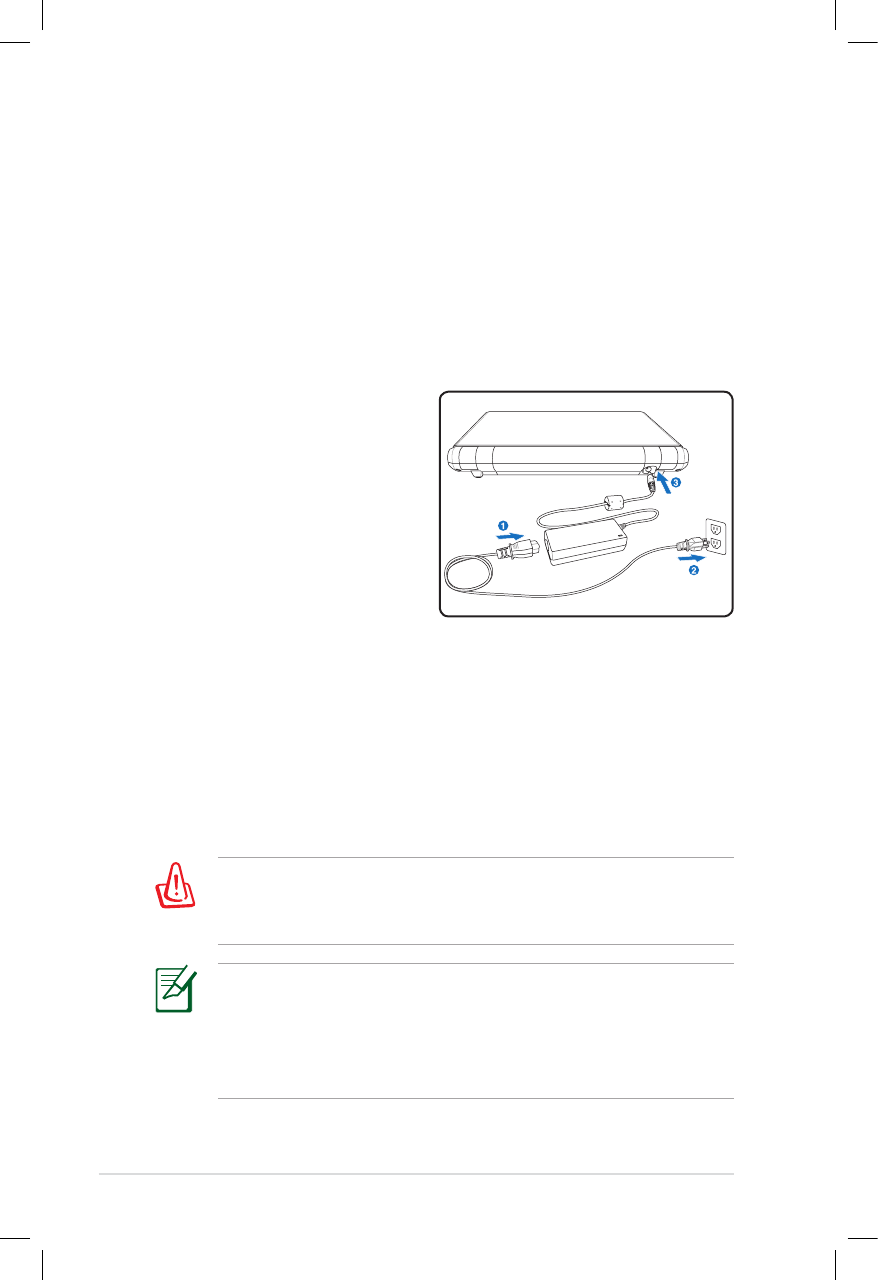
3-2
Chapter 3: Getting Started
This Eee PC may come with either a two or three-prong plug
depending on territory to fit your wall outlet. If a three-prong
plug is provided, you must use a grounded AC outlet or use a
properly grounded adapter to ensure safe operation of the Eee
PC.
THE POWER ADAPTER MAY BECOME WARM TO HOT WHEN IN
USE. BE SURE NOT TO COVER THE ADAPTER AND KEEP IT AWAY
FROM YOUR BODY.
Power System
Using AC Power
The Eee PC power comprises two parts, the power adapter and
the battery power system. The power adapter converts AC power
from a wall outlet to the DC power required by the Eee PC. Your Eee
PC comes with a universal AC-DC adapter for connection to any
100V-120V as well as 220V-240V outlets without setting switches or
using power converters. Different countries may require an adapter
to connect the provided US-
standard AC power cord to a
different standard. Most hotels
will provide universal outlets to
support different power cords as
well as voltages. It is always best
to ask an experienced traveler
about AC outlet voltages before
travelling.
With the AC power cord connected to the AC-DC converter, connect
the AC power cord to an AC outlet (preferably with surge-protection)
and then connect the DC plug to the Notebook PC. Connecting the
AC-DC adapter to the AC outlet first allows you to test the AC outlet’
s power and the AC-DC converter itself for compatibility problems
before connecting the DC power to the Notebook PC. The power
indicator on the adapter (if available) will light if the power is within
accepted ranges.
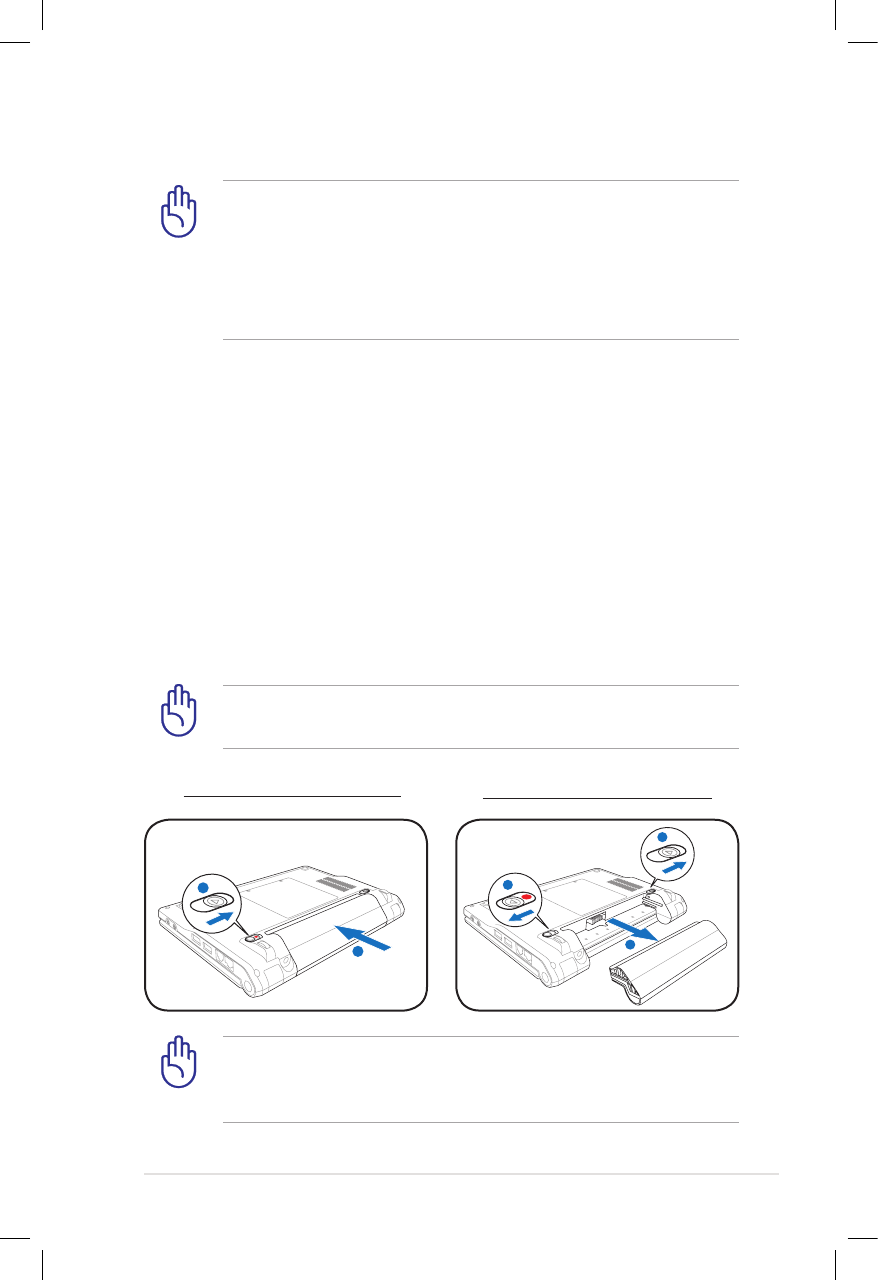
ASUS Eee PC
3-3
Damage may occur if you use a different adapter to power the
Eee PC or use the Eee PC’s adapter to power other electrical
devices. If there is smoke, burning scent, or extreme heat coming
from the AC-DC adapter, seek servicing. Seek servicing if you
suspect a faulty AC-DC adapter. You may damage both your
battery pack(s) and the Eee PC with a faulty AC-DC adapter.
Never attempt to remove the battery pack while the Eee PC is
turned ON, as this may result in the loss of working data.
Using Battery Power
The Eee PC is designed to work with a removable battery pack. The
battery pack consists of a set of battery cells housed together. A fully
charged pack will provide several hours of battery life. Additional
battery packs are optional and can be purchased separately through
an Eee PC retailer. Remember to fully charge the battery before first
use and whenever it is depleted to prolong battery life.
Installing and Removing the Battery Pack
Your Eee PC may not have its battery pack installed. If not, use the
following procedures to install the battery pack.
To install the battery pack: To remove the battery pack:
1
1
2
1
3
2
1
1
2
1
3
2
Only use battery packs and power adapters supplied with this
Eee PC or specifically approved by the manufacturer or retailer
for use with this model or else damage may occur to the Eee PC.
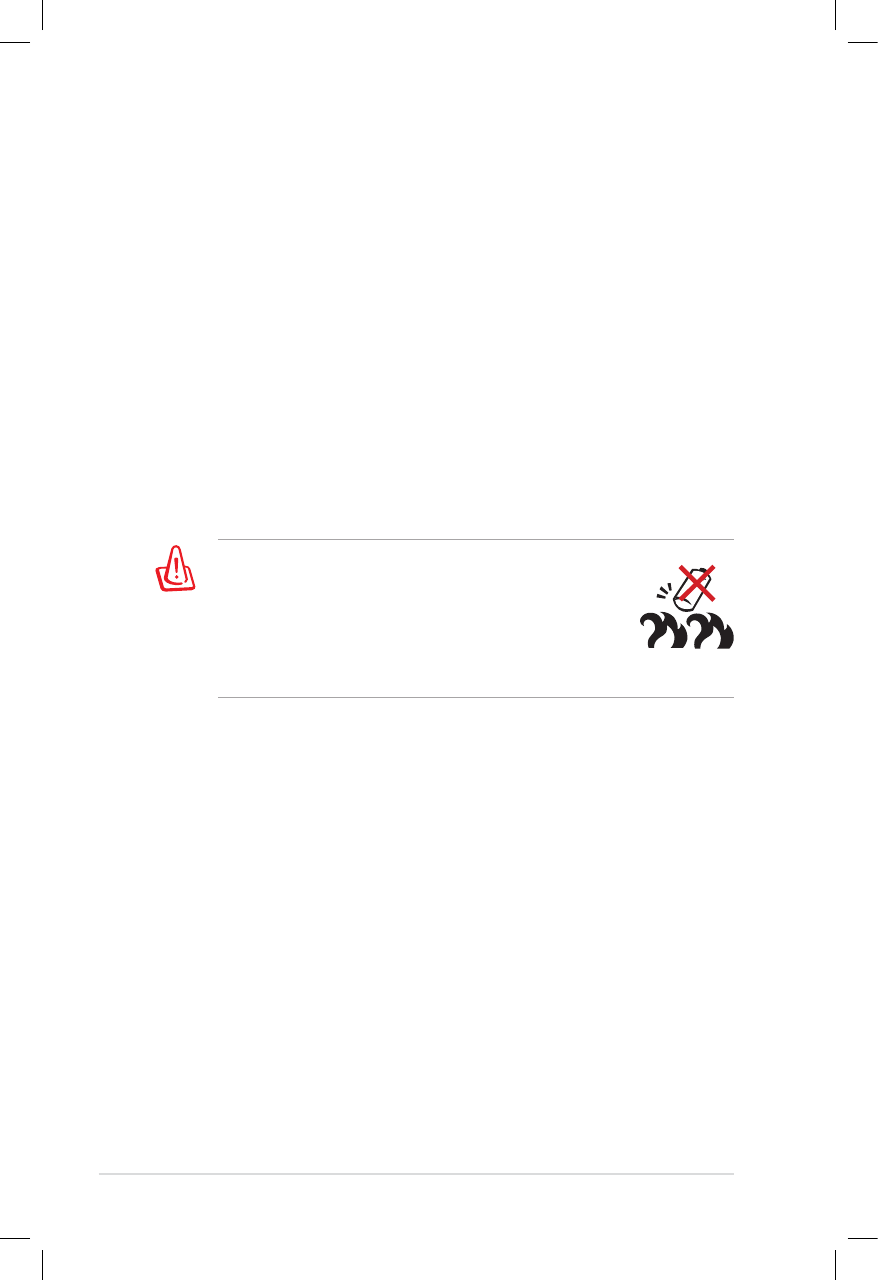
3-4
Chapter 3: Getting Started
For safety reasons, DO NOT throw the battery in
fire, DO NOT short circuit the contacts, and DO NOT
disassemble the battery. If there is any abnormal
operation or damage to the battery pack caused
by impact, turn OFF the Eee PC and contact an
authorized service center.
Battery Care
The Eee PC’s battery pack, like all rechargeable batteries, has a limit
on the number times it can be recharged. The battery pack’s useful
life will depend on your environment temperature, humidity, and
how your Eee PC is used. It is ideal that the battery be used in a
temperature range between 5˚C and 35˚C (41˚F and 95˚F). You
must also take into account that the Eee PC’s internal temperature
is higher than the outside temperature. Any temperatures above or
below this range will shorten the life of the battery. But in any case,
the battery pack’s usage time will eventually decrease and a new
battery pack must be purchased from an authorized dealer for this
Eee PC. Because batteries also have a shelf life, it is not recommended
to buy extras for storing.
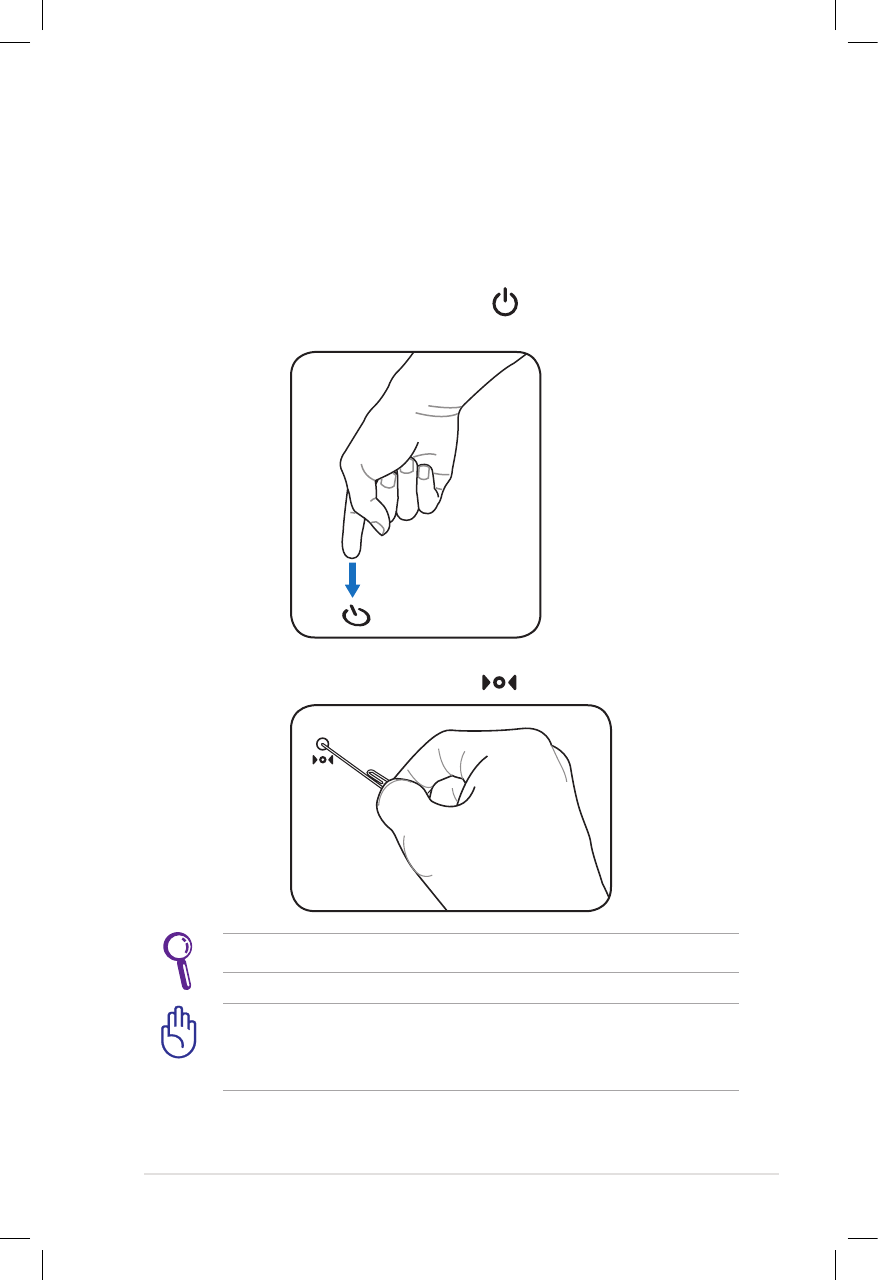
ASUS Eee PC
3-5
Emergency Shutdown & Reset
In case your operating system cannot properly turn OFF or restart,
there are additional ways to shutdown and reset your Eee PC:
Shutdown: Hold the power button until the system shuts
down.
DO NOT use emergency shutdown/reset while data is being
written or read; doing so can result in loss or destruction of your
data.
Use a pin or a straightened paper clip to press the reset button.
Reset: Press the reset button .
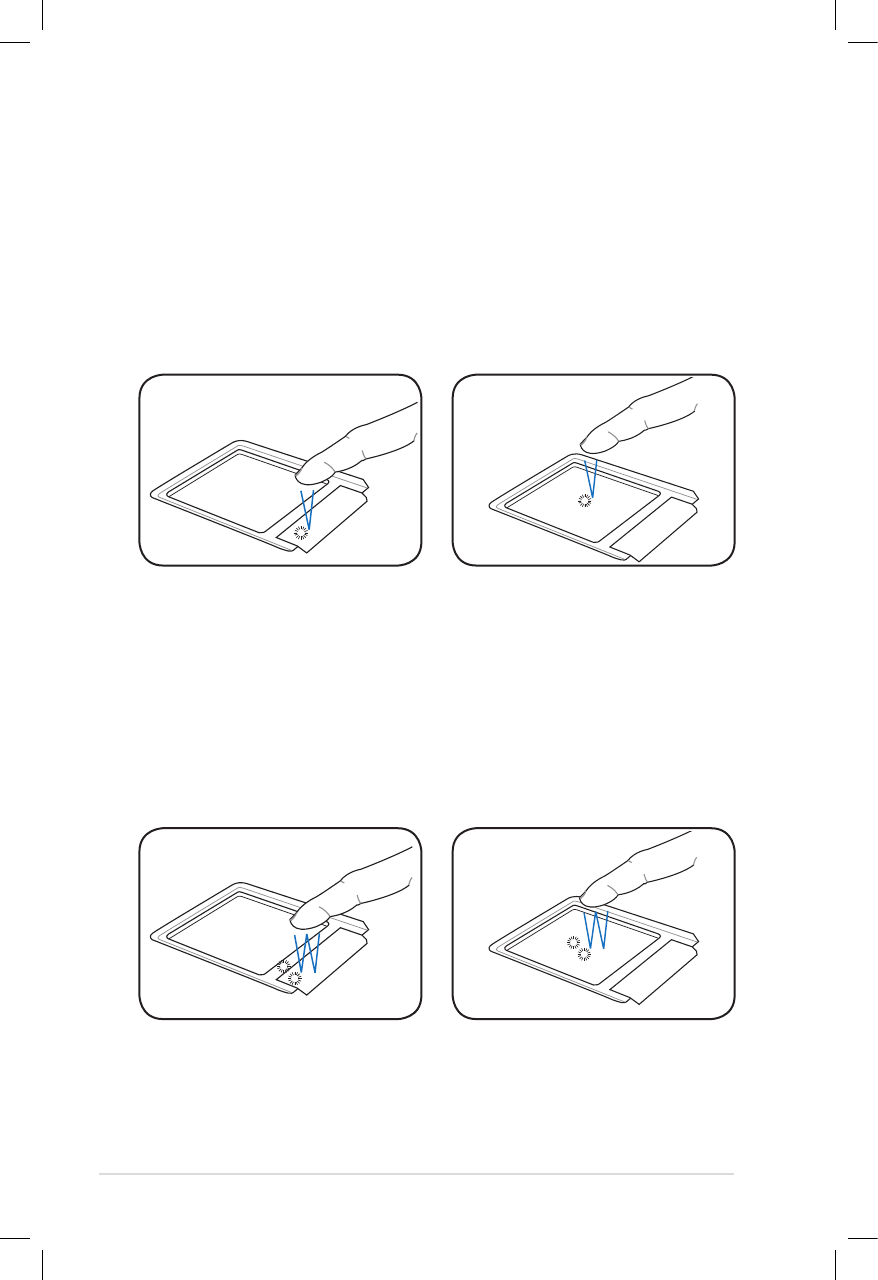
3-6
Chapter 3: Getting Started
Touchpad Usage
Single-finger gesture input
Clicking/Tapping - With the pointer over an item, press the left
button or use your fingertip to touch the touchpad lightly, keeping
your finger on the touchpad until the item is selected. The selected
item will change color. The following 2 illustrations produce the
same results.
Double-clicking/Double-tapping - This is a common skill for
launching a program directly from the corresponding icon you
select. Move the pointer over the icon you wish to execute, press the
left button or tap the pad twice in rapid succession, and the system
launches the corresponding program. If the interval between the
clicks or taps is too long, the operation will not be executed. The
following 2 illustrations produce the same results.
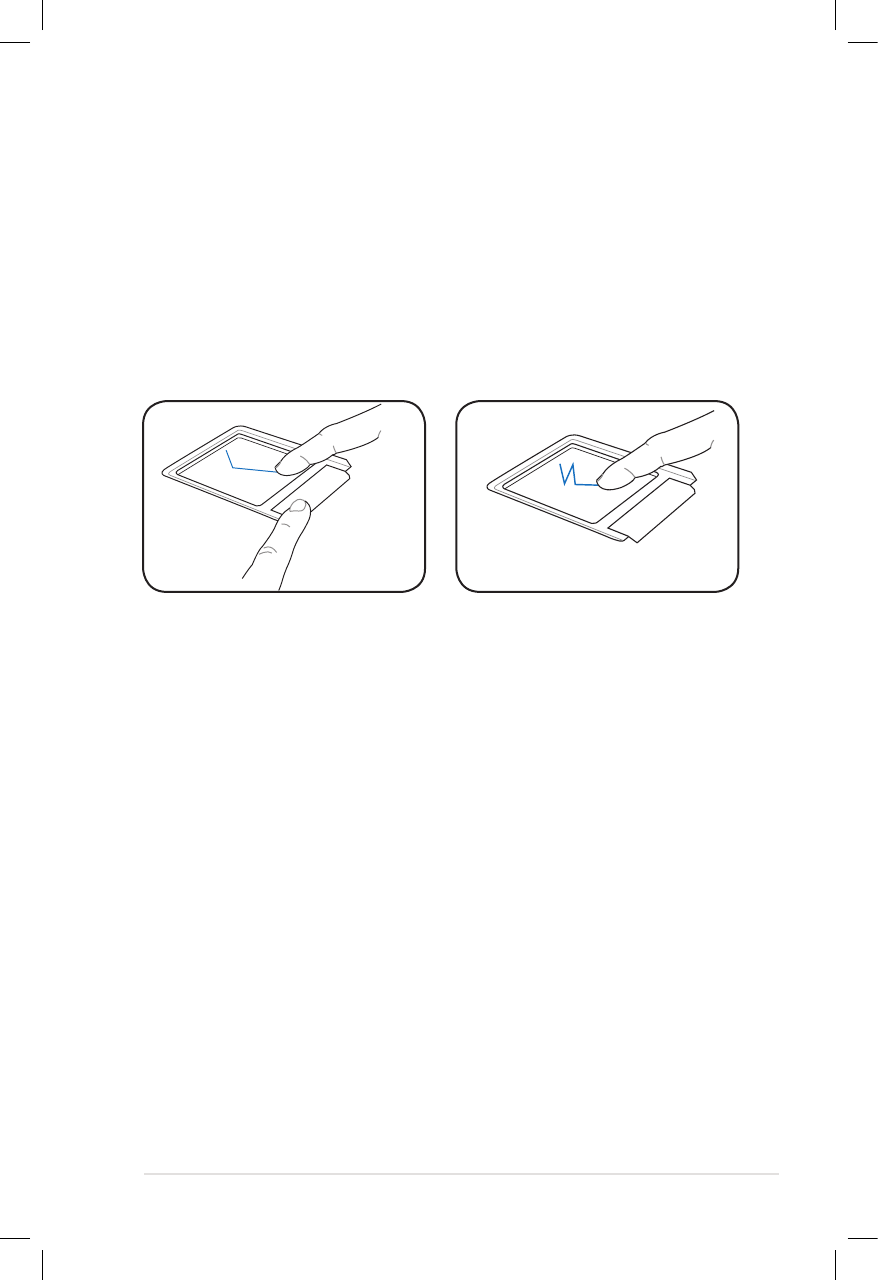
ASUS Eee PC
3-7
Dragging - Dragging means to pick up an item and place it
anywhere on the screen you wish. You can move the pointer over
the item you select, and while keeping the left button depressed,
moving the pointer to the desired location, then release the button.
Or, you can simply double-tap on the item and hold while dragging
the item with your fingertip. The following illustrations produce the
same results.
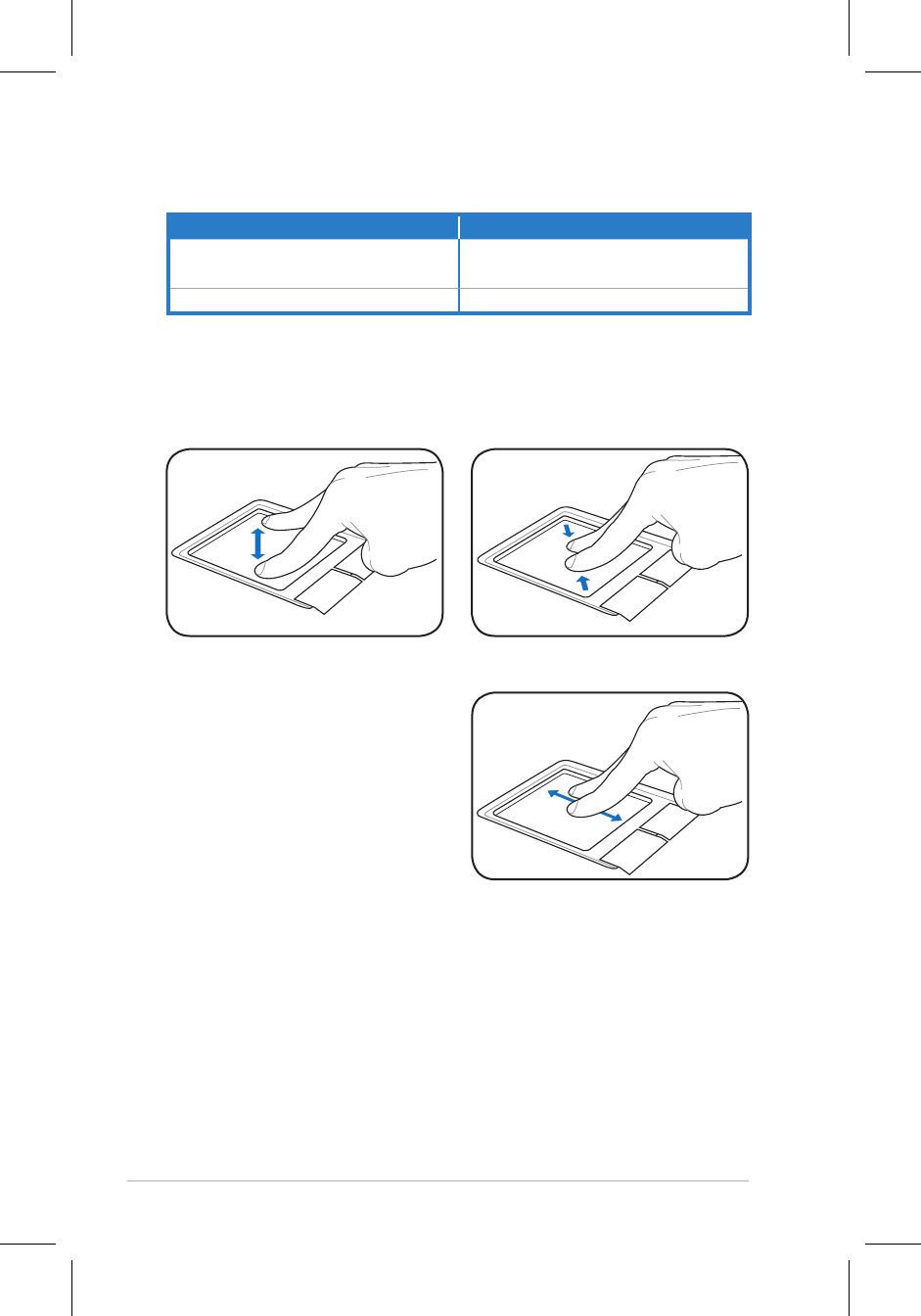
3-8
Chapter 3: Getting Started
Multi-finger gesture input
Two-finger scrolling - Use two
fingertips to slide up or down on
the touchpad to scroll a window
up or down. If your display window
includes several sub-windows,
move the pointer on that pane
before scrolling.
Zoom in Zoom out
Two-finger zooming in/out - Moving two fingertips apart or
together on the touchpad to zoom in or zoom out. This is convenient
when viewing photos or reading documents.
Finger gesture Applications
Two-finger zooming in/out OpenOffice Writer/Impress,
Adobe reader, Photomanager
Two-finger scrolling All
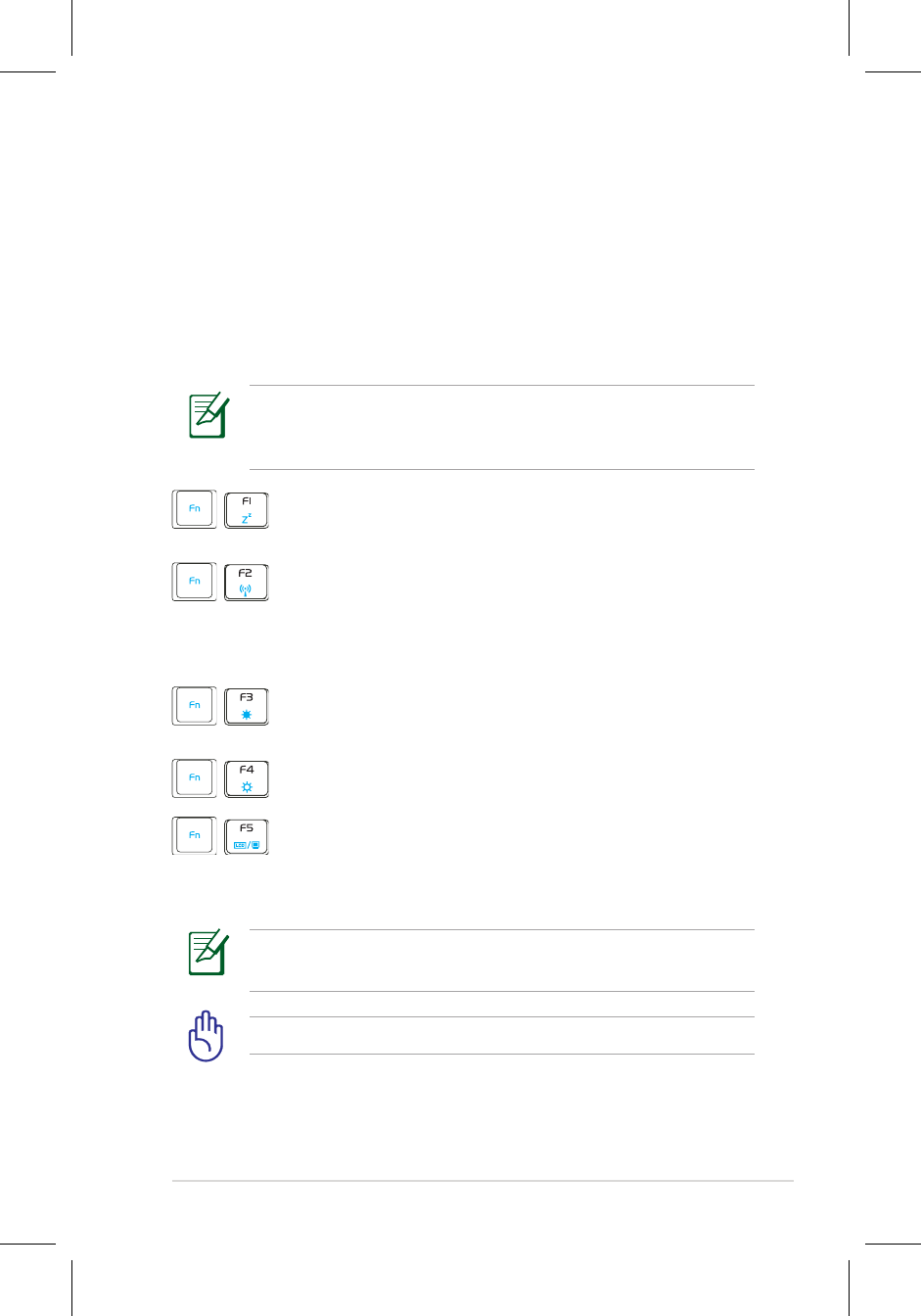
ASUS Eee PC
3-9
Keyboard Usage
Special Function Keys
The following defines the colored hot keys on the Eee PC’s keyboard.
The colored commands can only be accessed by first pressing
and holding the function key while pressing a key with a colored
command. Some function icons appear in the Notification area after
activation.
The Hot Key locations on the function keys may vary depending
on model but the functions should remain the same. Follow the
icons whenever your hot key locations do not match the manual.
zzZ Icon (F1): Places the Eee PC in suspend mode
(Save-to-RAM).
Radio Tower (F2): Wireless Models Only: Toggles
the internal wireless LAN ON or OFF with an on-
screen-display. When enabled, the corresponding
wireless indicator will light.
Sun Down Icon (F3): Decreases the display
brightness.
Sun Up Icon (F4): Increases the display brightness.
LCD/Monitor Icons (F5): Toggles between the Eee
PC’s LCD display and an external monitor in this
series: Eee PC LCD -> External Monitor -> Both.
Dual display mode does not work in 256 Colors, and supports a
resolution of 1024 x 600 pixels only.
Connect an external monitor before booting up the Eee PC.
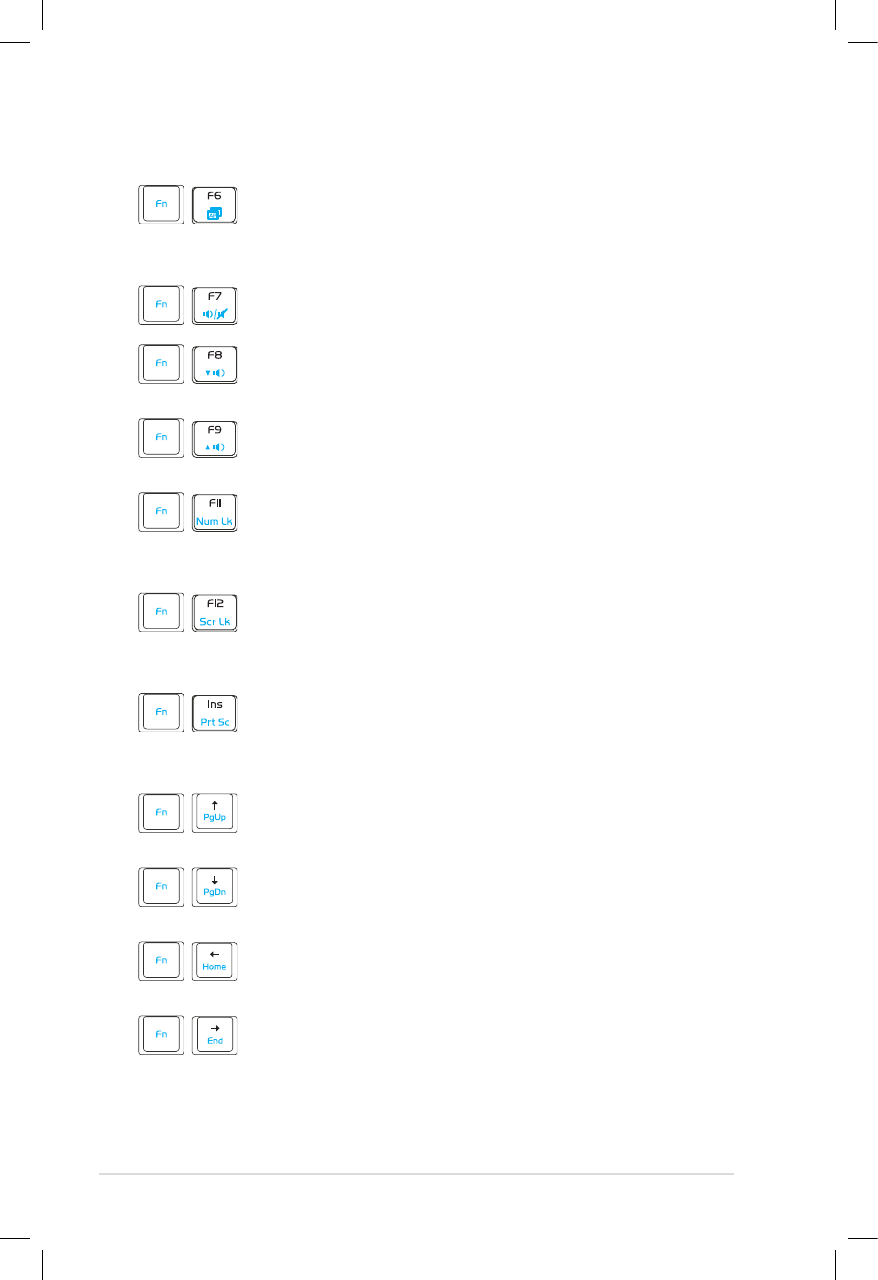
3-10
Chapter 3: Getting Started
Task Manager Icon (F6): Initiates the Task Manager
to view the application process or terminates
applications.
Crossed Speaker Icon (F7): Mutes the speaker.
Speaker Down Icon (F8): Decreases speaker
volume.
Speaker Up Icon (F9): Increases the speaker
volume.
Num Lk (F11): Toggles the numeric keypad (number
lock) ON and OFF. Allows use of a larger portion
of the keyboard for number entering.
Scr Lk (F12): Toggles the “Scroll Lock” ON and
OFF. Allows you to use a larger portion of the
keyboard for cell navigation.
Prt Sc (Ins): Toggles the “Print Screen” key to
initiate screen capture utility to capture, save, or
print the contents of entire desktop.
Pg Up (↑): Press to scroll up in documents or the
web browser.
Pg Dn (
↓
): Press to scroll down in documents or the
web browser.
Home (
←
): Press to move the pointer to the
beginning of the line.
End (
→
): Press to move the pointer to the end of
the line.

ASUS Eee PC
3-11
House icon: Returns to the main menu.
Menu with pointer icon : Activates the properties
menu and is equivalent to right-clicking the
touchpad/mouse on an object.
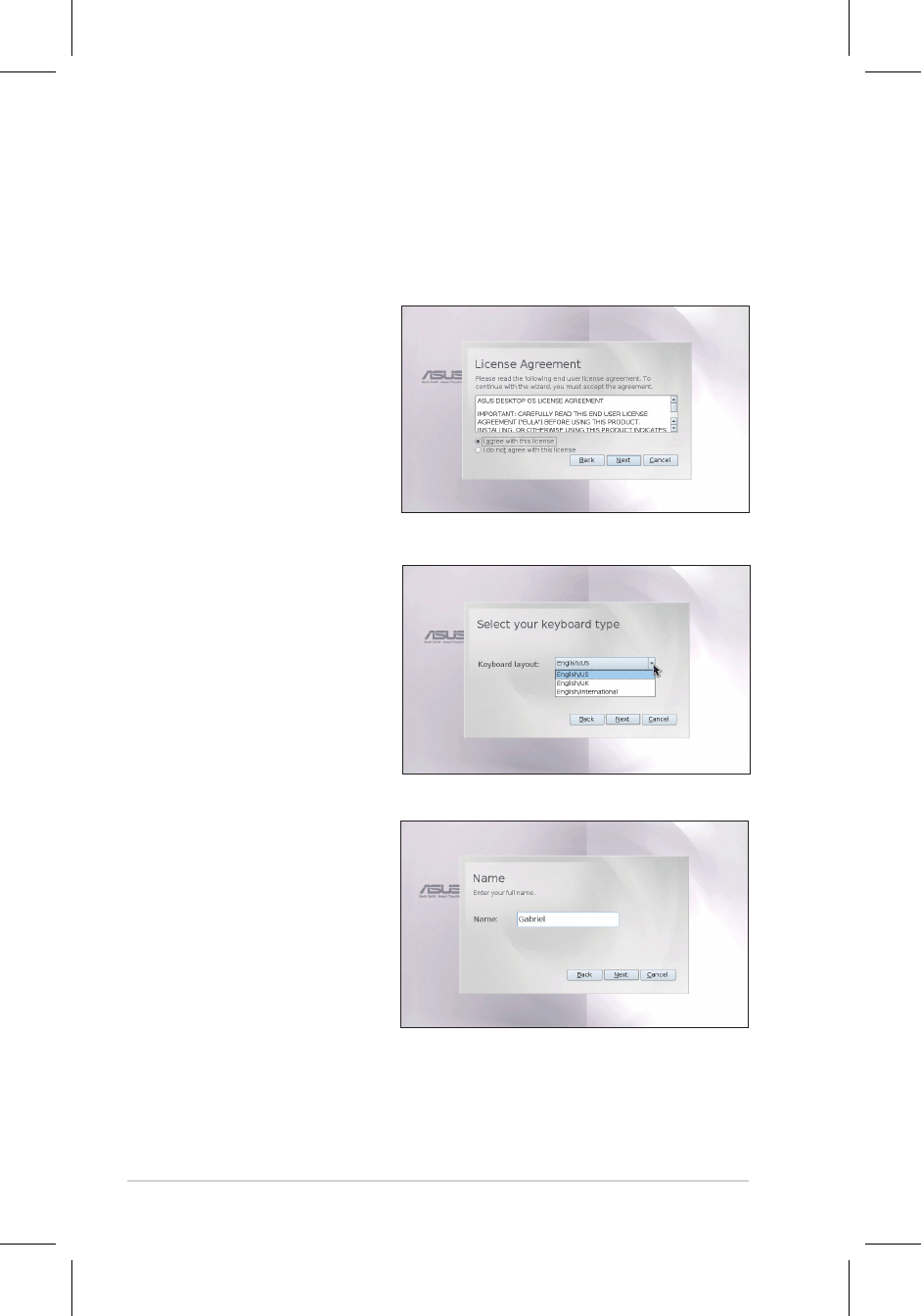
3-12
Chapter 3: Getting Started
First Run Wizard
For the first time you start your Eee PC, the First Run Wizard will
launch automatically and lead you through setting up your
preferences and some basic information. Follow the wizard
instructions to finish the initiation.
1. Toggle I agree with
this license and click
Next to continue.
2. Select your keyboard
type and click Next
to continue.
3. Enter your User
Name. Click Next to
continue.